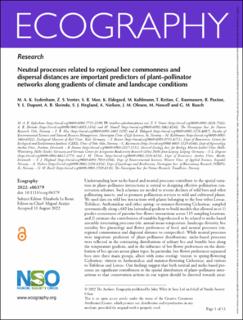| dc.description.abstract | Understanding how niche-based and neutral processes contribute to the spatial varia-tion in plant–pollinator interactions is central to designing effective pollination con-servation schemes. Such schemes are needed to reverse declines of wild bees and other pollinating insects, and to promote pollination services to wild and cultivated plants. We used data on wild bee interactions with plants belonging to the four tribes Loteae, Trifolieae, Anthemideae and either spring- or summer-flowering Cichorieae, sampled systematically along a 682 km latitudinal gradient to build models that allowed us to 1) predict occurrences of pairwise bee–flower interactions across 115 sampling locations, and 2) estimate the contribution of variables hypothesized to be related to niche-based assembly structuring processes (viz. annual mean temperature, landscape diversity, bee sociality, bee phenology and flower preferences of bees) and neutral processes (viz. regional commonness and dispersal distance to conspecifics). While neutral processes were important predictors of plant–pollinator distributions, niche-based processes were reflected in the contrasting distributions of solitary bee and bumble bees along the temperature gradient, and in the influence of bee flower preferences on the distri-bution of bee species across plant types. In particular, bee flower preferences separated bees into three main groups, albeit with some overlap: visitors to spring-flowering Cichorieae; visitors to Anthemideae and summer-flowering Cichorieae; and visitors to Trifolieae and Loteae. Our findings suggest that both neutral and niche-based pro-cesses are significant contributors to the spatial distribution of plant–pollinator inter-actions so that conservation actions in our region should be directed towards areas: Page 2 of 11near high concentrations of known occurrences of regionally rare bees; in mild climatic conditions; and that are surrounded by heterogenous landscapes. Given the observed niche-based differences, the proportion of functionally distinct plants in flower-mixes could be chosen to target bee species, or guilds, of conservation concern.Keywords: ecological networks, machine learning, plant–pollinator interactions, spatial, wild bees | |
